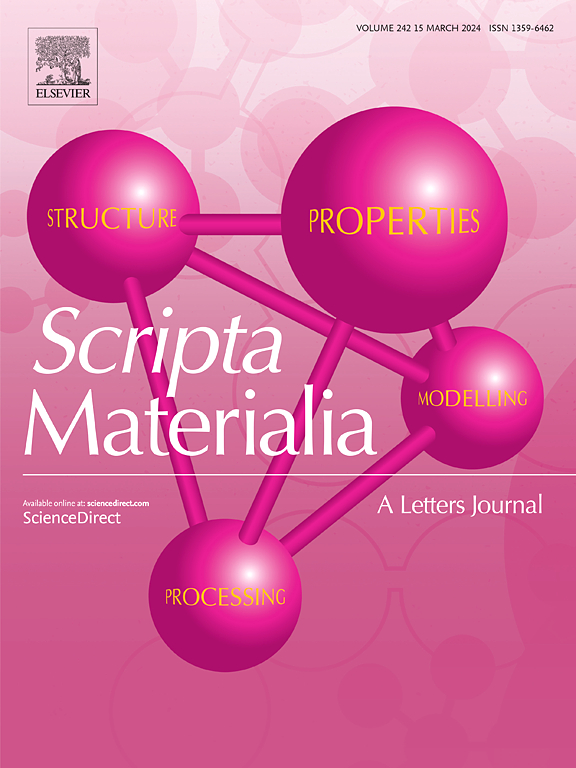利用双B2纳米沉淀物制备高强度、高韧性的微层双相中熵合金
IF 5.3
2区 材料科学
Q2 MATERIALS SCIENCE, MULTIDISCIPLINARY
引用次数: 0
摘要
非均质层合双相结构为克服合金的强度-延性平衡提供了一种很有前途的方法。然而,这通常是以断裂韧性为代价的,特别是在千兆帕级屈服强度下,由于界面上的应变不相容。在这项工作中,我们开发了一种铁基中熵合金(Fe-MEA),其特征是有序的体心立方(B2)纳米沉淀物嵌入层压面心立方(FCC)和体心立方(BCC)相中。这些工程界面作为多产、稳定和持久的位错源,大大提高了韧性,同时作为强大的位错屏障来提高强度。双纳米沉淀增强Fe-MEA表现出优异的性能组合:屈服强度为~ 1350 MPa,延展性为~ 18%,断裂韧性为~ 166 MPa·m0.5。动态晶粒细化和裂纹分支进一步增强了能量吸收。虽然在fe - mea中得到了展示,但这种结构设计策略为开发其他具有优异抗断裂性的强韧性合金(如复杂的多元素合金)提供了一条有希望的途径。本文章由计算机程序翻译,如有差异,请以英文原文为准。

Achieving high strength and toughness in microlaminated duplex medium entropy alloys via dual B2 nanoprecipitates
Heterogeneously laminated duplex structures offer a promising approach to overcoming the strength–ductility trade-off in alloys. However, this often comes at the expense of fracture toughness—particularly at gigapascal-level yield strengths—due to strain incompatibilities at interfaces. In this work, we develop a Fe-based medium entropy alloy (Fe-MEA) featuring ordered body-centered cubic (B2) nanoprecipitates embedded within laminated face-centered cubic (FCC) and body-centered cubic (BCC) phases. These engineered interfaces act as prolific, stable, and long-lasting dislocation sources, substantially improving toughness, while simultaneously serving as strong dislocation barriers to enhance strength. The dual-nanoprecipitate-reinforced Fe-MEA demonstrates an exceptional combination of properties: a yield strength of ∼1350 MPa, ductility of ∼18 %, and fracture toughness of ∼166 MPa·m0.5. Dynamic grain refinement and crack branching further contribute to enhanced energy absorption. Although showcased in Fe-MEAs, this structural design strategy offers a promising pathway for developing other strong and ductile alloys— such as complex multi-element alloys—with superior fracture resistance.
求助全文
通过发布文献求助,成功后即可免费获取论文全文。
去求助
来源期刊

Scripta Materialia
工程技术-材料科学:综合
CiteScore
11.40
自引率
5.00%
发文量
581
审稿时长
34 days
期刊介绍:
Scripta Materialia is a LETTERS journal of Acta Materialia, providing a forum for the rapid publication of short communications on the relationship between the structure and the properties of inorganic materials. The emphasis is on originality rather than incremental research. Short reports on the development of materials with novel or substantially improved properties are also welcomed. Emphasis is on either the functional or mechanical behavior of metals, ceramics and semiconductors at all length scales.
 求助内容:
求助内容: 应助结果提醒方式:
应助结果提醒方式:


